Decisive for this journey was the first description of Hemirhamphodon
kapuasensis (Anderson & Collette, 1991) which I did get first in the last year. The
photo of this species inspired me immediately and I decided to visit the river were they
were found. I wanted to bring them to Germany. First I was looking for literature of the
fishes of this region. Particularly the book of Roberts, 1989: " The Freshwater
Fishes of western Borneo " helped me to identify also other species which could be
interesting to bring to Germany. Roberts
(1989) had caught here already Hemirhamphodon kapuasensis in 1976. He counted the species
as a H. sp. unidentified and did the following executions: "A single small lot of Hemirhamphodon obtained in 1976 is not
identifiable with either H. phaiosoma or H. poponognathus. It may be H. chrysopunctatus or
an undescribed species. Colour in life not recorded.”
The Kapuas River is with 1143
kilometres length the biggest river of Indonesia and accommodates more than 300 fish
species. Particularly interesting here are some monotypical types like Eirmotus or
Ellopostoma as well as many endemic kinds, for example Parosphromenus anjuganensis,
Pectenocypris balaena or Parakysis anomalopteryx. The other preparations concerned baggage
and equipment, particularly the catch material as well as flights, inoculations and a lot
more. We decided to go by two people only because small groups are far more flexible than
bigger. Unfortunately, we got before the
beginning of the journey negative information, like the world-political position by the
attempts on the USA which promised nothing really property. In West-Kalimantan the
disturbances between the original population of the Dayaks and the settled people from
Madura were luckily finished. However on the homepage of the Foreign Ministry of Germany
was told that there would be many refugees of the Madura people in Pontianak, the city at
the estuary of the Kapuas River, our starting-point. So they could not recommend a journey
to this city. Because we arrived from Kuching, we decided to get out there when we would
have heard news of disturbances in Pontianak. From Kuching that belongs to Malaysia we
could look for some fishes in the region of Sarawak.
Sitting in the
airplane my fellow Rudi Moeschke told me that he had forgotten his money and the
traveller's cheques. Nice beginning. Also our arrival in Pontianak did not serve to
improve our mood after the flight which belonged 25 hours. The air smelled of
two-stroke-cycle engine gas and it was raining. Before we had selected a sort of pension,
called Wisma out of our travel guide where we wanted to go first. From there we decided to
do some one-day excursions in the closer region. Unfortunately it took three days to find
a guide. The guide we first tried to contact could not be spared at work. So he did send
his cousin. We had a vehicle suitable for our purposes a day later.
First we wanted
to visit the well known place between the cities of Anjugan
and Sungei Penjuh at the street from Pontianak direction Sintang behind Mandor.
Already Roberts (1989) and many members of
the IGL (German Labyrinthfish Association) had mentioned this discovery place. For the
Labyrinthfish people particularly the species of Parosphromenus anjuganensis and P.
ornaticauda as well as Betta rutilans were interesting. On the bases of the coordinates we
took by a GPS, we could find the our place of interest immediately. Here we would have
stopped anyway even without these coordinates because of the beauty.
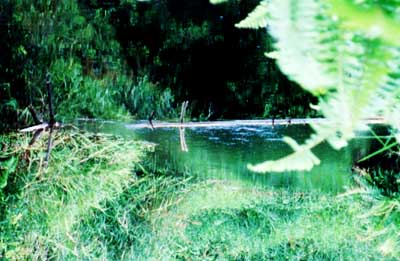
Biotope 1 a small forest stream © 2001 Michael
Schlüter
A man made canal was floating parallel to the
street and crossed by a picturesque small forested stream. We were still near to the
coast. It was the place of the first description of Betta rutilans and Parosphromenus anjuganensis, next to
the place of the first description of P. ornaticauda, 53 kilometres by car from Pontianak
in the lowlands, called Sungei Kepayang. Up to one kilometre pineapple fields hemmed the
street, here was overgrown civilized country. From the primary forest which still stood
here till some years, we did find only a few traces. Some bigger trees stood at the course
of the river, but most of the trees were still relatively young. The bank dropped steeply
and was relatively rich in structure by plants which hung into the water. The moderately
to fast floating water was very clear and looked brown to black tinted, like coffee. The
small stream was 1,20 meters deep and between 6 and 10 meters wide. Everywhere in the
water we found wood storages as well as bamboo and bulrushes which were growing over the
surface of the water. Furthermore a lot of bulrushes where alga spread out between. Here
trees were still cutted in the hinterland and brought by man on small ways up to street.
Partly the wood was also stored in the water. On 28/09/01 we could measure at 4.00 o'clock
p.m. the air temperature with 28 °C and the following water values: water temperature 26
°C with a pH factor of 4,11 and 33 µ s/ccm³. Our catch equipment consisted several push
nets, with and without a handle and a four meters long dip net.
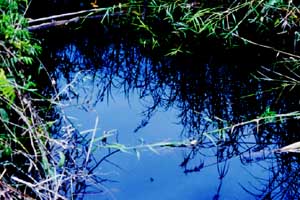 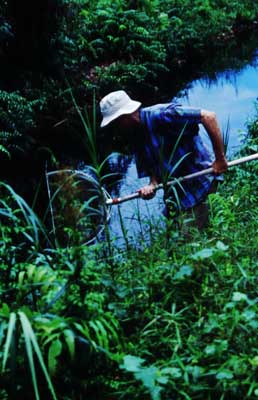
Biotope 1 man made canal © 2001 Michael Schlüter
Rudi is fishing © 2001 Michael Schlüter
As means of
transport we used high tubs which are normally used as a water-reservoir for washing as
well as plastic bags for fish transport. First we tried to catch the fish by a push net
with a handle from out of the water in the man made canal. Here we could catch Rasbora
pauciperforata with a beautiful dark red longitudinal stripe next to Rasbora dorsiocellata
which had a russet body colour and our first Licorice Gourami, Parosphromenus anjuganensis
as well as a female of Betta rutilans. Unfortunately, in spite of intense efforts also
during other days, it remained with this single female. In the small forested river we
could already catch a lot of species, Robert's (1989) did catch before in 1976: Rasbora
dorsiocellata, R. pauciperforata and R. agilis, Osteochilus spilurus, Puntius
rhomboocellatus, Sundadanio axelrodi found in the green variant, Neohomaloptera
johorensis, Kryptopterus macrocephalus, Hemirhamphodon poponognathus, Betta cf. taeniata,
Parosphromenus anjuganensis, P. ornaticauda, Belontia hasselti and Sphaerichthys
osphromenoides osphromenoides. Only the goby Roberts (1989) caught, Stigmatogobius brocki we could not find. But there were some other
species he has not caught like Luciocephalus pulcher, a not identified snakehead and a small loach which we decided to take with us
because of their beautiful colouration and the interesting examination. It could be
Kottelatlimia pristes or a related species.
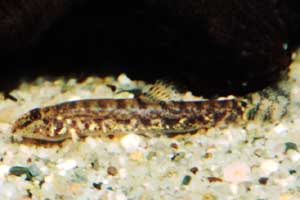 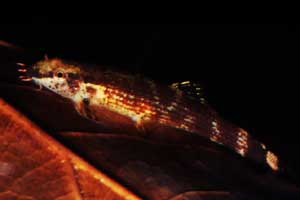
Kottelatlimia pristes ©
2001 Michael Schlüter
Neohomaloptera johorensis © 2001 Michael Schlüter
They were found in the slowly floating water in the mud between leaves. There we also
caught a few species of Parosphromenus ornaticauda which Roberts (1989) thought it is P.
parvulus. P. anjuganensis identified by Roberts (1989) as P. deissneri lived rather in the
overhanging grass on the bank catch. In faster flowing areas Neohomaloptera johorensis
were be found which inspired us on account of their low size, the orange colour in the
tailfin and the two red coloured maxillary barbels on each side. Also from this kind we
did bring some specimen to Germany. We could catch the beautiful Sundadanio axelrodi only
with the dip net in the weakly flowing free water an sometimes in unique specimens by push
net in the flat water at the bank. With one draught we did get up to 150 specimen of this
kind. Besides we caught also some Puntius rhomboocellatus, Rasbora agilis and
Sphaerichthys osphromenoides.
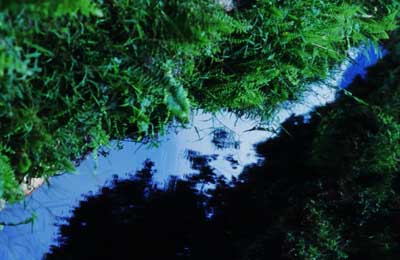
Biotope 1 man made canal © 2001 Michael
Schlüter
Luciocephalus and Channa stood in the flat water in the bank area, we caught Belontia in
the ditch in bank nearness. Because we struck out with our white bodies and the partly
rather peculiar clothes, like surf shoes or tropical hat our nice and helpful guide
Kasigen had a good time. A lot of people which liked to know what the funny Europeans were
doing in this river, stopped their car and talked to Kasigen, because we did not
understand their language. They often had a good laugh. One day there were two fishermen
who catched regularly Sundadanio for the export and reported us that approx. 4 months ago
already a Japanese girl had caught here and in other rivers a lot of fish. Because of the
high number of interesting fish species not farther astonishing.
Part 2
|
